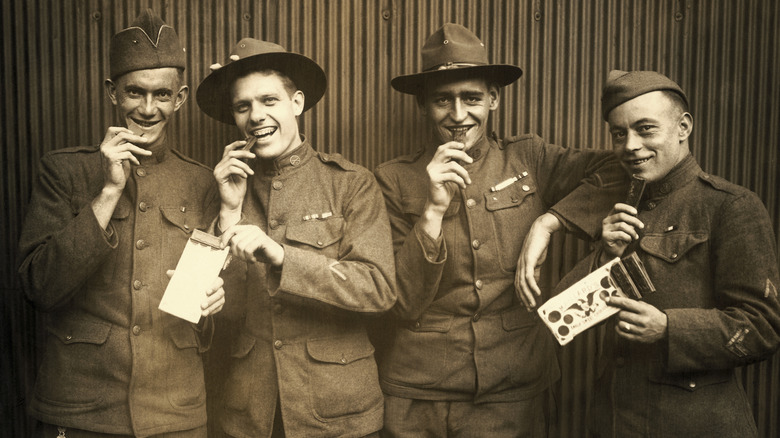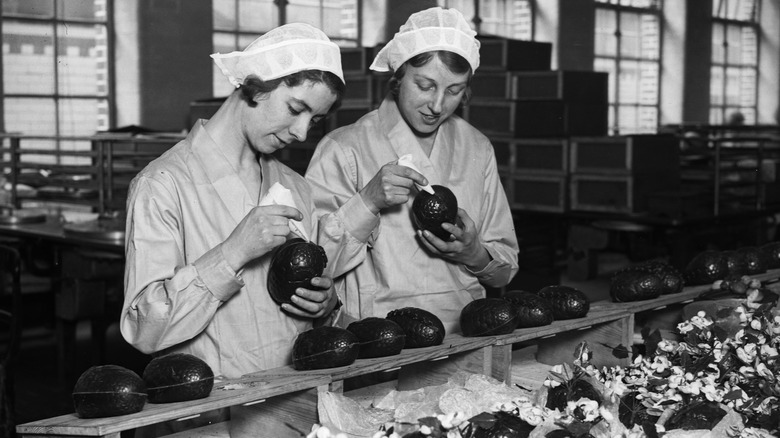World War I Actually Led To The Popularization Of Candy Bars
Today, candy bars line the shelves of stores everywhere. You can't even escape your local drugstore without having to resist the temptation. Oddly enough, we have World War I to thank for this.
The relationship between candy bars and soldiers began in Europe, where chocolates were rationed among British soldiers to boost morale. Seeing this work, the U.S. army followed suit. Originally, 20-pound blocks of chocolate were cut down and rewrapped, then distributed to U.S. soldiers. The plan worked, and the army saw an uptick in both resolve and energy (as it did with instant coffee). While the goal was short-term, it birthed a hearty appetite for chocolate for soldiers returning from the front lines, and thus, the U.S. candy bar market exploded.
Prohibition and the Great Depression caused massive ebbs and flows in the candy bar market but, ultimately, the industry spiked and large companies like Mars and The Hershey Company faced new competition from local chocolate manufacturers trying to capitalize on the new craving.
Candy's role in other wars
During active duty, soldiers carry food rations consisting of basic, high-protein, high-energy foods to keep them going. These are also called MREs — Meals Ready to Eat. Part of every food ration is dessert, but these aren't usually indulgent. Still, candies have proved time and time again to improve soldiers' spirits.
During the Spanish Civil War, troops ate Smarties as the tempered candy shell allowed the chocolates to travel well, and this was apparently such a good idea that it led Forrest Mars Sr. to develop M&Ms. Peanut Chews were actually originally invented as part of WWI soldiers' food rations and became so popular that they moved to mass market after the war. Tootsie Rolls have been a military favorite since WWII owing to their incredibly durable consistency. They are famed for their role in the Korean War (as is fried chicken), where U.S. Marines accidentally ordered a boatload of the candies after a radio operator misunderstood what the Marines were actually after (ammunition). The Marines enjoyed the sweet surprise and even ingeniously developed ways to use Tootsie Rolls as bullet-hole seals.
The Cold War introduced West German children to the Candy Bomber, 1st Lieutenant Gail Halvorsen. Halvorsen was a pilot with the U.S. Air Force who famously dropped candy for children to enjoy throughout the Berlin Blockade. Halvorsen saw first-hand that children were sharing rations with each other and was moved to lift their spirits during one of the country's hardest periods.
Chocolate still boosts army morale today
WWI kicked off the relationship between candy and soldiers' attitudes, and it's still going strong today. Today, U.S. troops have a lot more variety, with over 20 MRE menus to choose from. Present in all of these menus is a sweet treat. These include pudding cups, cookies (though our chewy pumpkin chocolate chip cookies are probably better), cobblers, chocolate bars, pound cakes, and more. The Defense Logistics Agency proudly notes that vegetarian, halal, and kosher MREs are now available to troops, and while it's a rite of passage for soldiers to complain about the food, everybody tends to enjoy the desserts.
As the program has evolved, an increasingly large factor in creating MREs is whether the troops actually like the food or not. Soldiers' feedback is used to help the Combat Feeding Directorate (CFD) develop new products and adjust recipes.
For those wishing to send troops candy or food as a gift, beware that there are strict guidelines. Candy bars still need to be near-non-perishable in order for the U.S. army to approve them, proving that the old military chocolate may not have been as tasty, but any chocolate is better than no chocolate.



